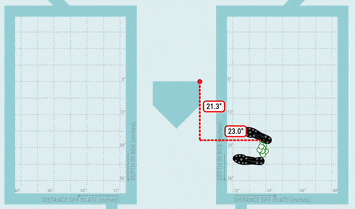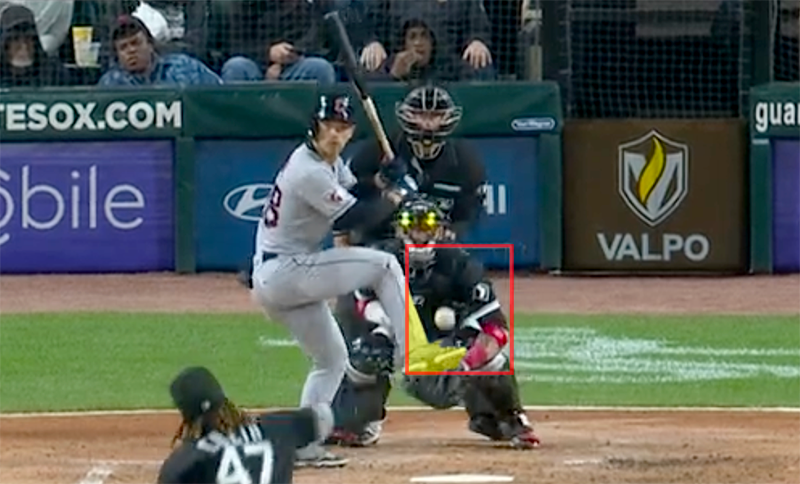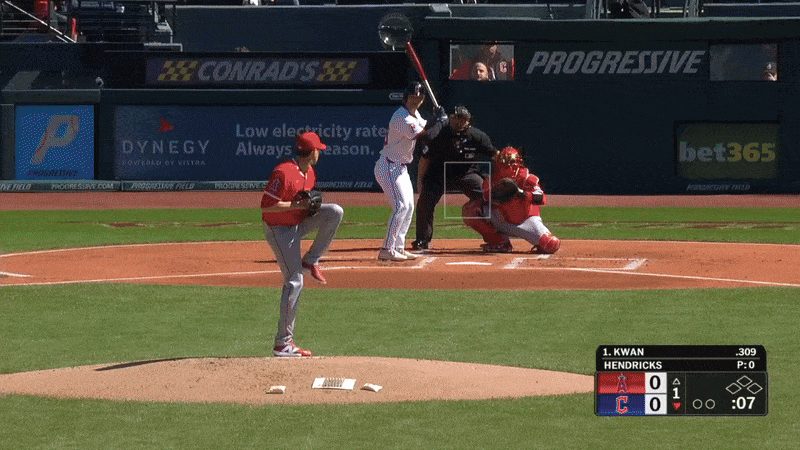Steven Kwan Is Passing the Old Man Test

So there’s this thing called the old man test. It’s been around for at least five or six years, but it’s making the rounds on the Internet again. The idea is simple enough. You have to put on your socks and shoes without letting your feet touch the ground as you do so. You raise your left foot and keep it in the air while you reach down to the ground to grab your sock, put it on, reach down to the ground to grab your shoe, put it on, and tie it, then you do the same thing with your right foot. It tests your balance, strength, flexibility, and all those other things bodies are supposed to have. If you fail the test, then you’re an old man, I guess? Maybe you instantly turn into an old man? Maybe a healthy old man just appears right outside your window to point and laugh at you? That part’s less clear.
I tend to buy into the idea that the old man test is measuring something important, just because whenever I’ve had to do physical therapy, I’ve been forced to do a lot of one-legged exercises. If you’ve ever been in physical therapy, I bet you’ve had to do them too. There’s nothing physical therapists love more than turning up the difficulty level of an otherwise simple exercise by forcing you to do it while standing on one leg. Once you get good at doing it one-legged, they’ll make you stand on a bouncy ball or something, and if you nail that, they’ll literally just start shoving you to make it even harder. Truly, no one on earth is hornier for balance than physical therapists.
I bring all this up because I noticed something fun about Steven Kwan while playing around with Baseball Savant’s batting stance graphics the other day. The graphics take after ballroom dancing diagrams of old, showing fun little footprints for each player at three points: their resting batting stance, when the pitcher releases the ball, and when their bat actually intercepts the ball. Here’s Kwan’s 2024 graphic:

Kwan has one of the narrowest batting stances in the game, so his front foot moves out toward the mound quite a bit, but aside from that, nothing about it stands out all that much. He’s a little guy with a little stance, film at 11. But this is the calm before the storm. Here’s the same graphic for this month. Keep your eye on the blue footprint:

I was so confused when I watched this. Is Steven Kwan actually stepping on home plate as the pitcher releases the ball? It seemed like something I would’ve noticed before, but there was that blue footprint, right on top of home plate, clear as day. How could anyone start a swing with their body so closed off? And is it even legal to step on home plate in the middle of your swing? That definitely seems like it would be illegal. I pulled up the rulebook and started looking before I realized what was actually going on. If you’re familiar with Kwan’s swing, I’m sure you already know the answer, and it brings us back to the old man test.
Kwan doesn’t step on home plate, but he has one of the game’s most dramatic leg kicks, and right in the middle of it, he dangles his foot directly over the plate. There’s no way to indicate in a two-dimensional diagram that his foot is 18 inches off the ground. Sometimes, and I’m not exaggerating here, Kwan’s entire foot is inside the strike zone while the ball is already on its way to home plate. No batter has ever come closer to tying their shoe in the middle of a pitch:

I went back to Baseball Savant and watched every single qualified player’s batting stance diagram, hundreds of cleats dancing across the batter’s boxes, black to blue to red. I would very roughly estimate that half of today’s hitters don’t move their front foot all that much, but that still leaves scores and scores of players with dramatic leg kicks, their blue front feet moving every which direction. None of those players does what Kwan does. None of them does anything remotely resembling what Kwan does. When batting from the right side, Ozzie Albies does place most of his left foot outside the batter’s box, but that’s mostly because he sets up five inches closer to the plate than Kwan does, and his foot is still nowhere near home plate. Nobody’s diagram looks like Kwan’s because nobody’s leg kick looks like Kwan’s.
Here’s Kwan’s secret. He doesn’t just have a leg kick. He has a leg kick, and then, right in the middle of it, he has second leg kick. It’s a double kick. A normal leg kick just involves lifting your foot off the ground, and it’s maybe worth noting that this is a bit of a misnomer. Everywhere outside the baseball diamond, there’s a difference between raising your leg and kicking. In baseball, they’re one and the same. Regardless, Kwan does that, pulling his knee straight up until his femur is parallel with the ground, but he’s just getting going. At that point, he kicks his foot forward toward home plate and sweeps it out toward the pitcher in a circular motion as he puts it down:

Kwan has a leg kick, and then he has a foot kick. It would not be at all unfair to say that he puts his right foot in and shakes it all about. It’s an impressive display of balance, and so far as I can tell, it’s unique. I didn’t just watch all the diagrams. I watched the swings of every player I could think of who has a big leg kick. I watched YouTube videos that compiled huge leg kicks of the past. The closest leg kicks I could find belonged to Alek Thomas and Gary Sánchez, both of whom move their front foot while they get into their swing, but they’re far from doing a double kick. No one else does this.
Kwan didn’t start executing the double kick all at once. It seems like it’s been coming on for a while now. When he was drafted out of Oregon State in 2018, Kwan had a small, controlled leg kick, with no double kick in sight. I can’t find any video of him from the next two years, but he started 2021 with the very beginnings of a double kick:
It’s very subtle in the video above. By the time Kwan debuted in 2022, the double kick was there to stay, but it’s still evolving. As he told the MLB Network during spring training, he went into the 2024 season looking to impact the ball harder, and that meant a more aggressive leg kick. “Before, I’d get up and then I would just put it right back down,” he said. “So then my hands are able to work and I can manipulate the bat as I need to. But last year, I tried to – hitter leverage, early in the count – really try to get that stride out, and now I’m going out to get it. I can stay in the legs, and then now I can stay slotted, catch it out a little more in front.” The funny thing is that in the video, even as Kwan demonstrated the leg kick (which he called a leg lift), he wasn’t doing the double kick. He may not even know he’s doing it. It’s only in the heat of the game that the double kick happens.
This focus on going out and meeting the ball earlier is likely the reason it only started showing up on the Baseball Savant diagram this season. It has to do with his timing. This year, the second kick actually seems like it’s not quite bringing his foot as far forward or as high, but it’s also quicker. If Statcast could show us its full path, it would likely look nearly identical to the 2024 or 2023 path, but it’s only showing us its position at the moment the ball is released. At that point, Kwan is further along, so his foot is already over the plate. He’s also getting his foot down a fraction of a second earlier, and it’s possible that getting started that little bit earlier is part of the reason he’s running a career-low opposite field rate.
Watch any baseball game and you’ll see 18 different hitters with 18 different timing mechanisms. Nobody’s exactly the same, but they tend to fall in a couple of categories. There are players with quiet feet, players with toe taps, and players with leg kicks. Those leg kicks take their feet in pretty much every direction. Some players lift their leg straight up, some pull their foot way back as a cocking mechanism, some use the leg kick to true up a very open stance, some start narrow and push their foot toward the pitcher. But Kwan is the only one who just dangles his foot there, then kicks it out into the strike zone before he attacks the pitch. It’s a feat of ingenuity as well as a feat of balance. At the very least, he should be every physical therapist’s favorite player.
Davy Andrews is a Brooklyn-based musician and a writer at FanGraphs. He can be found on Bluesky @davyandrewsdavy.bsky.social.
I had never seen these graphics before. I quickly went to look at Jacob Wilson’s chart. I was sure it would look like he’s riverdancing in the box. Plenty of movement but I was hoping for so much more.
I’d be interested to see these graphics generated for Juan Soto after he takes a pitch.